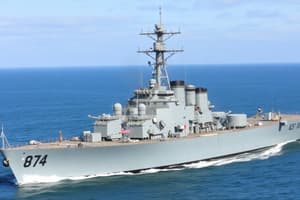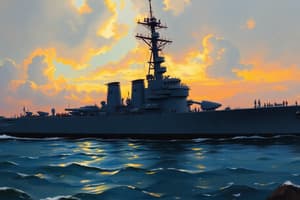Podcast
Questions and Answers
Which capability distinguishes the Arleigh Burke-class destroyers from many previous guided-missile cruisers?
Which capability distinguishes the Arleigh Burke-class destroyers from many previous guided-missile cruisers?
- Emphasis on purely anti-submarine warfare.
- Smaller size and lighter armament for enhanced maneuverability.
- Lower operational costs and reduced crew size.
- Larger size and heavier armament. (correct)
What makes the Arleigh Burke-class destroyers' hull design unique, contributing to improved performance at sea?
What makes the Arleigh Burke-class destroyers' hull design unique, contributing to improved performance at sea?
- A new large, water-plane area-hull form with a wide flaring bow for improved seakeeping. (correct)
- A narrow, deep-draft hull for enhanced stability.
- A traditional vertical bow for efficient wave cutting.
- A flat bottom hull for shallow water operations.
What primary technology enables the Arleigh Burke-class destroyers to perform anti-aircraft warfare effectively?
What primary technology enables the Arleigh Burke-class destroyers to perform anti-aircraft warfare effectively?
- Anti-submarine rockets (ASW)
- Aegis Combat System and SPY-1D radar. (correct)
- Ship-to-ship missiles and guns (ASuW)
- Tomahawk missiles
Besides anti-air and anti-surface capabilities, what other warfare domains are Arleigh Burke-class destroyers equipped to handle?
Besides anti-air and anti-surface capabilities, what other warfare domains are Arleigh Burke-class destroyers equipped to handle?
What design element is incorporated into the Arleigh Burke-class destroyers to reduce their radar signature?
What design element is incorporated into the Arleigh Burke-class destroyers to reduce their radar signature?
What historical event marked the Arleigh Burke-class as the U.S. Navy's sole active destroyer type?
What historical event marked the Arleigh Burke-class as the U.S. Navy's sole active destroyer type?
How have the Arleigh Burke-class destroyers evolved to enhance their capabilities in ballistic missile defense?
How have the Arleigh Burke-class destroyers evolved to enhance their capabilities in ballistic missile defense?
What is the significance of the Arleigh Burke class in terms of production longevity among U.S. Navy surface combatants?
What is the significance of the Arleigh Burke class in terms of production longevity among U.S. Navy surface combatants?
What primary factor led the Navy to revert to all-steel construction for surface combatants after experimenting with aluminum superstructures?
What primary factor led the Navy to revert to all-steel construction for surface combatants after experimenting with aluminum superstructures?
What specific lesson learned from the Falklands War influenced the design of the Arleigh Burke-class destroyers?
What specific lesson learned from the Falklands War influenced the design of the Arleigh Burke-class destroyers?
What was the original intended role of the Zumwalt-class destroyers that led to their initial production?
What was the original intended role of the Zumwalt-class destroyers that led to their initial production?
Why did the Navy decide to restart Arleigh Burke-class destroyer production after initially planning to focus on the Zumwalt class?
Why did the Navy decide to restart Arleigh Burke-class destroyer production after initially planning to focus on the Zumwalt class?
What is the key difference between the "restart" Arleigh Burke-class destroyers (DDG 113-115) and previous Flight IIA ships?
What is the key difference between the "restart" Arleigh Burke-class destroyers (DDG 113-115) and previous Flight IIA ships?
What led to the cancellation of the plan to extend Arleigh Burke-class destroyer acquisition into the 2040s?
What led to the cancellation of the plan to extend Arleigh Burke-class destroyer acquisition into the 2040s?
What was the Navy's proposed procurement plan for Arleigh Burke-class destroyers after the cancellation of the extended acquisition plan?
What was the Navy's proposed procurement plan for Arleigh Burke-class destroyers after the cancellation of the extended acquisition plan?
In addition to restart ships having modernized components, what is another way in which they are similar to previous ships?
In addition to restart ships having modernized components, what is another way in which they are similar to previous ships?
Flashcards
Arleigh Burke Class
Arleigh Burke Class
US Navy guided-missile destroyer class, known for Aegis Combat System and SPY-1D radar.
SPY-1D Radar
SPY-1D Radar
Multi-function passive electronically scanned array radar, a key component of the Aegis system.
Arleigh Burke (Person)
Arleigh Burke (Person)
An American destroyer admiral in WWII, the namesake of the Arleigh Burke class.
Arleigh Burke Missions
Arleigh Burke Missions
Signup and view all the flashcards
Aegis Ballistic Missile Defense
Aegis Ballistic Missile Defense
Signup and view all the flashcards
USS Arleigh Burke (DDG-51)
USS Arleigh Burke (DDG-51)
Signup and view all the flashcards
Wide Flaring Bow
Wide Flaring Bow
Signup and view all the flashcards
Stealth Techniques
Stealth Techniques
Signup and view all the flashcards
Arleigh Burke class construction material
Arleigh Burke class construction material
Signup and view all the flashcards
Why restart Arleigh Burke production?
Why restart Arleigh Burke production?
Signup and view all the flashcards
Longest production run
Longest production run
Signup and view all the flashcards
DDG 113-115 designation
DDG 113-115 designation
Signup and view all the flashcards
Arleigh Burke procurement cancellation reason
Arleigh Burke procurement cancellation reason
Signup and view all the flashcards
Arleigh Burke procurement plan (2023-2027)
Arleigh Burke procurement plan (2023-2027)
Signup and view all the flashcards
Double-spaced steel layers
Double-spaced steel layers
Signup and view all the flashcards
Zumwalt class original focus
Zumwalt class original focus
Signup and view all the flashcards
Study Notes
- The Arleigh Burke class is a class of United States Navy guided-missile destroyers (DDGs).
- It centers around the Aegis Combat System.
- It uses the SPY-1D multi-function passive electronically scanned array radar.
- The class is named after Arleigh Burke, a World War II destroyer admiral and later Chief of Naval Operations.
- The destroyers range from 505 to 509.5 feet (153.9 to 155.3 m) in overall length.
- Displacement ranges from 8,300 to 9,700 tons.
- They carry over 90 missiles.
- The Arleigh Burke-class destroyers are larger and more heavily armed than many previous guided-missile cruisers.
- These are multi-mission destroyers.
- They conduct anti-aircraft warfare with Aegis and surface-to-air missiles.
- Tactical land strikes are carried out with Tomahawk missiles.
- Anti-submarine warfare (ASW) is enabled with towed array sonar, anti-submarine rockets, and ASW helicopters.
- Anti-surface warfare (ASuW) is conducted with ship-to-ship missiles and guns.
- Upgrades to the AN/SPY-1 radar systems and missile payloads support the Aegis Ballistic Missile Defense System.
- The class can function as mobile anti-ballistic missile and anti-satellite platforms.
- USS Arleigh Burke, the lead ship, was commissioned on 4 July 1991, during Admiral Burke's lifetime.
- With the decommissioning of USS Cushing on 21 September 2005, the Arleigh Burke-class ships became the U.S. Navy's only active destroyers.
- The Zumwalt class became active in 2016.
- The Arleigh Burke class has the longest production run of any U.S. Navy surface combatant.
- As of December 2024, all seventy-four built are active.
- Nineteen more are planned to enter service.
Structure
- The Arleigh Burke-class ships are among the largest destroyers built in the United States.
- Only the Spruance, Kidd (563 ft or 172 m), and Zumwalt classes (600 ft or 180 m) are longer.
- The class was designed with a new large, water-plane area-hull form and a wide flaring bow.
- These features improve seakeeping ability and permit high speed in high sea states.
- The design incorporates stealth techniques, such as angled surfaces and a raked tripod mainmast.
- These features make the ship more difficult to detect by radar.
- Lessons from the Ticonderoga-class cruiser were incorporated.
- The U.S. Navy returned to all-steel construction, except for the aluminum mast.
- The Ticonderogas had combined a steel hull with a lighter aluminum superstructure.
- Aluminum proved vulnerable to cracking and is less fire-resistant than steel.
- A 1975 fire aboard USS Belknap gutted her aluminum superstructure.
- Battle damage to Royal Navy ships during the 1982 Falklands War supported the decision to use steel.
- Lessons from the Falklands War led to the Navy's decision to protect vital spaces with double-spaced steel layers.
- These layers create a buffer against anti-ship missiles.
Production Restarted
- USS Michael Murphy (DDG-112) was originally intended to be the last of the Arleigh Burke class.
- The Navy planned to shift production to the Zumwalt-class destroyer, focusing on NGFS and littoral operations.
- In July 2008, Navy officials announced intentions to restart Arleigh Burke production instead of additional Zumwalts.
- This was due to the Zumwalt's inability to counter emerging ballistic missiles, anti-ship missiles, and blue-water submarines.
- Arleigh Burke-class destroyers have been in production for longer than any other surface combatant class in U.S. Navy history.
- In April 2009, the Navy announced a plan limiting the Zumwalt class to three units.
- Another three Arleigh Burke-class ships were ordered from both Bath Iron Works and Ingalls Shipbuilding.
- In December 2009, Northrop Grumman received a $170.7 million contract for USS John Finn (DDG-113) long lead-time materials.
- Shipbuilding contracts for DDG 113 to DDG 115 were awarded in mid-2011 for $679.6 million–$783.6 million.
- These contracts do not include government-furnished equipment such as weapons and sensors.
- The average cost of the FY2011/12 ships was about $1.843 billion per vessel.
- DDG 113 through 115 are "restart" ships, similar to previous Flight IIA ships.
- These ships include modernization features such as OACE and the TB-37U MFTA, which are being backfit onto previous ships.
- The U.S. Navy was considering extending the acquisition of Arleigh Burke-class destroyers into the 2040s.
- In April 2022, the Navy proposed a procurement plan for nine ships, with an option for a tenth.
- The plan was to build two ships a year from 2023 to 2027.
- Some lawmakers pushed to add a third ship to be built in 2023, bringing the total of the proposed deal to eleven ships.
- The Navy followed a two-ship per year procurement from 2018 to 2022.
Studying That Suits You
Use AI to generate personalized quizzes and flashcards to suit your learning preferences.
Description
The Arleigh Burke-class is a United States Navy class of guided-missile destroyers (DDGs) centered around the Aegis Combat System and the SPY-1D radar. These multi-mission destroyers conduct anti-air, anti-submarine, anti-surface, and strike warfare. They are named after Arleigh Burke, a World War II destroyer admiral.


